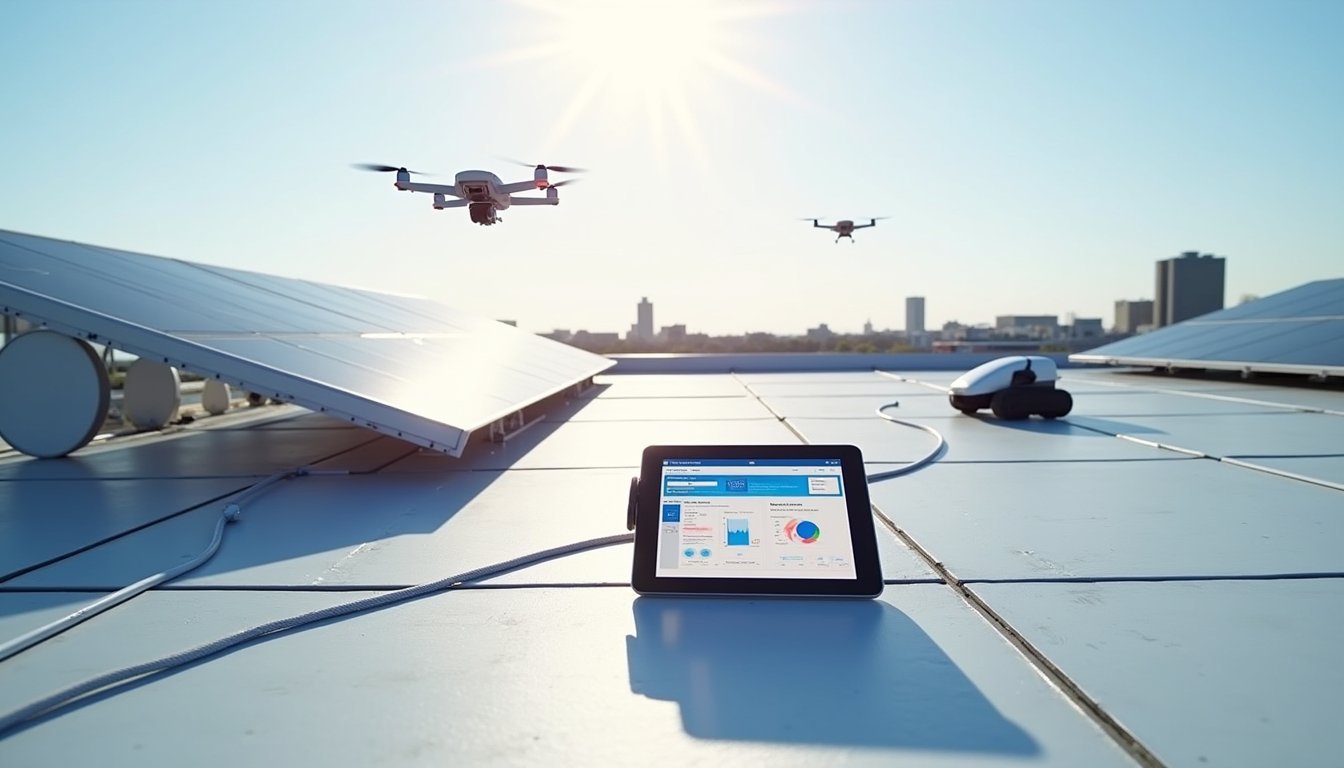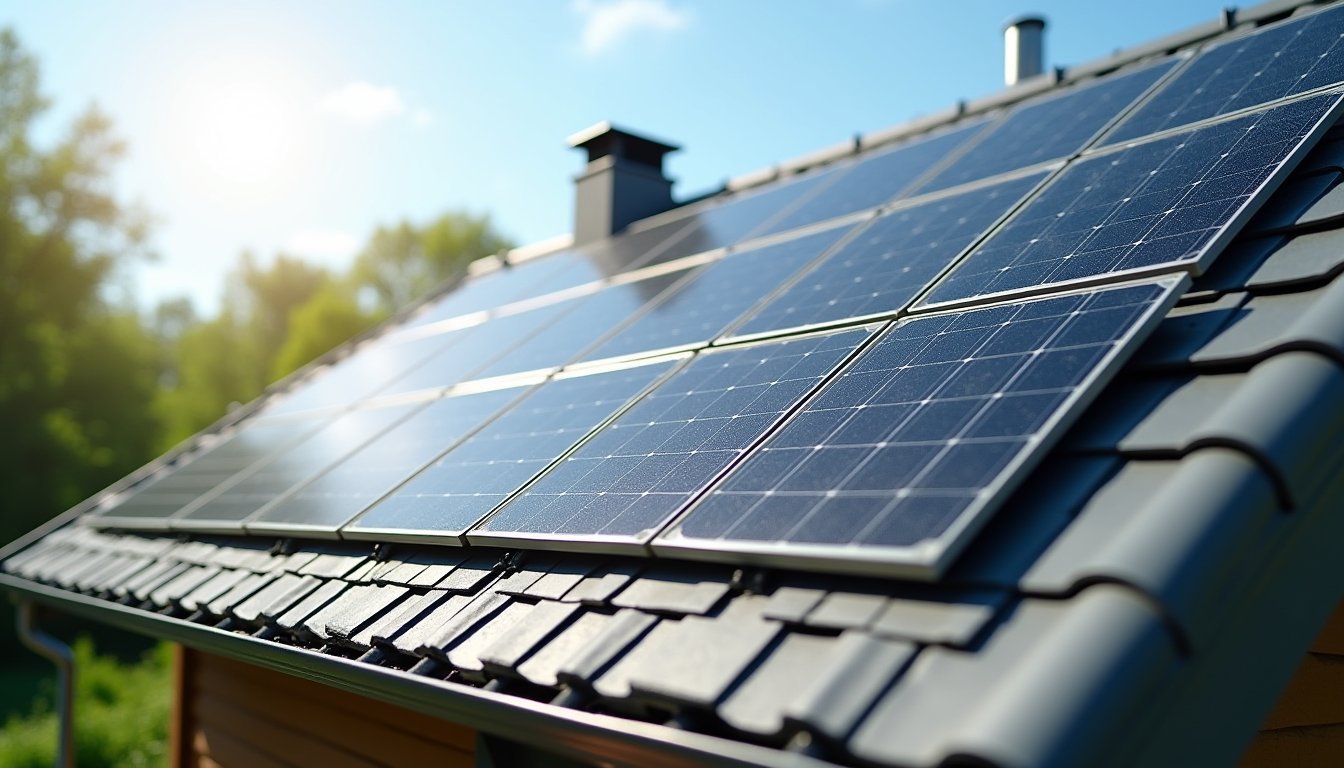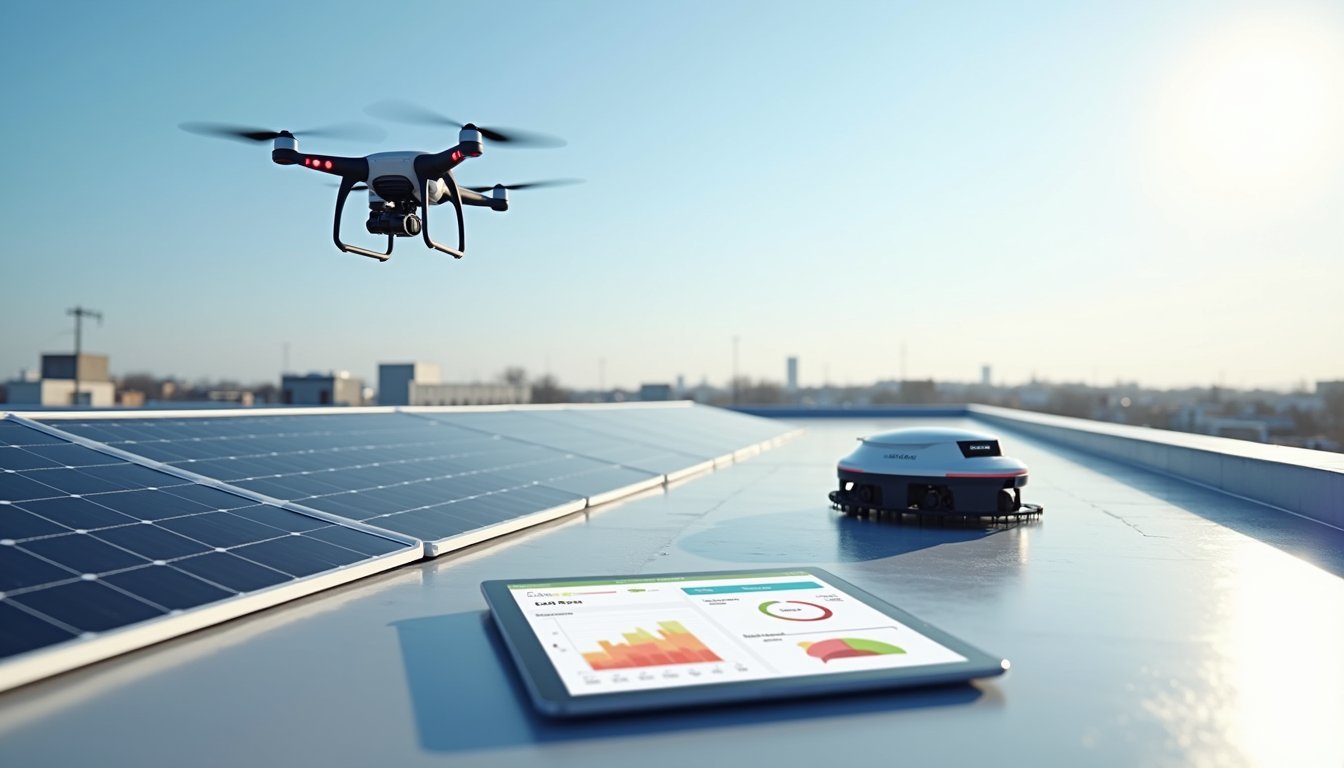Professional roofing contractors now combine traditional craftsmanship with cutting-edge technology to transform your roof into a smart, sustainable system. You’ll find they use drone-mounted thermal imaging, 3D modeling, and AI-powered assessment tools to deliver precise installations and repairs. They’ll integrate solar solutions, smart monitoring systems, and eco-friendly materials while ensuring strict compliance with modern building codes. Understanding today’s professional roofing services can help you make informed decisions about your property’s future.
Advanced Technology Integration in Modern Roofing

As roofing technology continues to evolve, professional contractors in 2025 are leveraging sophisticated digital tools and smart systems to revolutionize their operations.
You’ll find contractors using drone-mounted thermal imaging sensors to detect moisture intrusion and structural weaknesses before they become major issues. These systems work in tandem with predictive maintenance algorithms that analyze data to forecast potential roof failures and schedule timely interventions.
Smart roof monitoring systems now integrate with building management platforms, providing real-time updates on roof performance and environmental conditions. Automated roof cleaning systems, equipped with sensors and programmable routes, maintain your roof’s integrity while reducing manual labor. Solar-integrated materials and weather-responsive coatings communicate with central monitoring hubs, adjusting their properties to optimize energy efficiency and extend your roof’s lifespan.
Digital Assessment and Project Planning
You’ll find that modern roofing contractors increasingly rely on drone technology to conduct thorough aerial inspections, capturing high-resolution imagery and thermal data of roof conditions. Through advanced software integration, these drone-captured images are processed into detailed 3D models, enabling precise measurements and material calculations. Your project estimates become more accurate as contractors use these digital models to identify potential challenges, plan material layouts, and determine labor requirements before ever setting foot on your roof.
Drone Inspection Technology Today
While traditional roof inspections often require physical climbing and manual measurements, modern drone technology has revolutionized how professional contractors assess and plan roofing projects. You’ll find that today’s drones integrate AI-powered analysis and sensor-based inspections to deliver precise data about your roof’s condition.
| Drone Feature | Benefit | Application |
|---|---|---|
| Thermal Imaging | Heat Loss Detection | Energy Efficiency |
| HD Photography | Damage Documentation | Insurance Claims |
| LiDAR Sensors | 3D Modeling | Project Planning |
| Moisture Detection | Leak Prevention | Maintenance |
These advanced inspection tools enable you to receive extensive digital reports without risking worker safety on steep slopes. Your contractor’s drone system can quickly identify potential issues, measure dimensions accurately, and create detailed documentation all while reducing inspection time and costs significantly.
3D Modeling For Estimates
Modern 3D modeling technology transforms roofing estimates into precise digital assessments. You’ll see contractors using parametric design software to create detailed virtual replicas of your roof structure, complete with exact measurements and material specifications.
These digital models help you visualize the final project before work begins, ensuring accuracy in material quantities and cost calculations. The 3D modeling process identifies potential challenges early, from complex angles to drainage issues, allowing contractors to develop targeted solutions. You’ll receive thorough estimates that account for every aspect of the project, including labor costs and material requirements.
The technology integrates with project management systems, enabling contractors to track progress, manage resources, and maintain quality control throughout the renovation process. This digital approach extensively reduces estimation errors and improves project outcomes.
Sustainable Materials and Green Solutions

Professional roofing contractors are integrating Tesla-style solar shingles and other photovoltaic roofing materials that’ll seamlessly combine energy generation with traditional roof protection. You’ll find that recycled roofing materials, including rubber-based shingles made from reclaimed tires and composite products derived from post-consumer waste, are becoming standard options in sustainable roofing projects. These eco-friendly alternatives moreover reduce landfill waste but also offer superior durability and lower long-term maintenance costs compared to conventional materials.
Solar Shingle Integration
As renewable energy continues transforming the construction industry, solar shingle integration has emerged as a game-changing solution for residential and commercial roofing. You’ll find that modern roofing contractors now offer customized solar panel design services that seamlessly blend with your existing roof architecture while maximizing energy production.
These ideal systems don’t just capture sunlight; they’re engineered to work with advanced energy storage solutions, allowing you to power your property even during non-peak hours. Your contractor will assess your roof’s orientation, pitch, and local climate conditions to determine perfect placement and system specifications. They’ll also handle the complex integration of power inverters, monitoring systems, and grid connections, ensuring your solar shingles meet both aesthetic requirements and energy efficiency goals while complying with local building codes.
Recycled Roofing Options
Why settle for traditional roofing materials when today’s recycled options deliver both environmental benefits and superior performance? Professional roofing contractors now offer an extensive range of sustainable solutions made from repurposed materials, including rubber tiles manufactured from old tires and composite shingles containing recycled content from post-consumer waste.
You’ll find these eco-friendly alternatives match or exceed conventional materials in durability and weather resistance. Modern recycled roofing products feature improved UV protection, superior impact resistance, and longer lifespans than their traditional counterparts. Many options incorporate recycled content from diverse sources: reclaimed wood fiber, plastic bottles, and metal components. These materials undergo rigorous testing to meet strict building codes and industry standards. Your contractor can help you select the most suitable recycled roofing solution that aligns with your budget and environmental goals.
Smart Roofing System Installation
Smart roofing system installation requires specialized expertise to integrate advanced monitoring sensors, smart ventilation controls, and IoT-enabled components into your existing or new roof structure. You’ll need contractors who understand roof automation protocols and can properly calibrate sensor-enabled maintenance systems to protect your investment.
Your contractor will install moisture detection arrays, temperature monitoring nodes, and structural stress sensors throughout the roofing system. They’ll connect these components to a central hub that provides real-time data about your roof’s condition. The system automatically adjusts ventilation based on weather conditions and alerts you to potential issues before they become costly problems. This predictive maintenance approach extends your roof’s lifespan and optimizes its performance while reducing long-term maintenance costs through automated monitoring and early intervention.
Building Code Compliance and Safety Standards

Modern roofing technologies must align with increasingly complex building codes and safety regulations that evolve alongside industry innovations. You’ll need to stay current with building code updates that address new materials, installation methods, and environmental requirements. These regulations now incorporate specifications for smart roofing systems, solar integration, and automated maintenance protocols.
Safety regulation changes in 2025 require you to implement advanced fall protection systems, use AI-monitored safety equipment, and follow strict protocols for working with emerging roofing materials. You’re responsible for ensuring your projects meet local, state, and federal compliance standards, including new energy efficiency mandates and structural load requirements. Your documentation must include digital verification of code compliance, real-time safety monitoring data, and automated inspection reports to maintain your professional certification.
Project Management and Client Communication
Managing multiple roofing projects efficiently requires three core digital platforms: cloud-based project management software, real-time communication tools, and automated scheduling systems. You’ll integrate these platforms to streamline workflow, bolster strategic planning, and preserve client satisfaction throughout each project phase.
Your project management software tracks material deliveries, crew assignments, and milestone completions, while automated scheduling systems optimize resource allocation and weather-dependent task planning. Real-time communication tools keep clients informed through personalized dashboards, enabling them to view project progress, approve change orders, and access documentation immediately.
You’ll capitalize on these digital solutions to coordinate subcontractors, manage permit applications, and address client concerns promptly. This integrated approach secures transparent project delivery and helps maintain your reputation as a reliable roofing contractor in 2025’s competitive market.
Energy Efficiency and Environmental Impact
As sustainability drives construction standards in 2025, you’ll need to integrate energy-efficient materials and eco-conscious practices into every roofing project. Your expertise must extend beyond traditional roofing to include renewable energy integration, such as solar shingle installation and smart roofing systems that optimize energy consumption.
You’ll work with cutting-edge insulation advancements, implementing materials that enhance thermal efficiency while minimizing environmental impact. This includes installing reflective coatings that reduce heat absorption and incorporating recycled materials that meet stringent environmental regulations. Your role now encompasses calculating energy savings potential for clients and ensuring roofing systems comply with zero-emission building codes.
Quality Control and Performance Monitoring
Professional roofing contractors in 2025 must implement detailed quality control systems that utilize real-time monitoring technology and data analytics. You’ll find that quality assurance procedures have evolved to include automated inspection tools and AI-driven performance reporting metrics that track your roof’s condition continuously.
Advanced roofing technology now demands sophisticated monitoring systems and AI-driven analytics to ensure peak performance and durability.
Key monitoring systems you’ll benefit from include:
- Digital thermal mapping that detects moisture infiltration and insulation gaps before they become visible
- Structural integrity sensors that measure load distribution and material stress in real-time
- Smart coating systems that report UV degradation and chemical exposure levels directly to your contractor’s dashboard
These advanced monitoring solutions guarantee your roof meets industry standards while providing documented evidence of maintenance needs and repair interventions. You’ll receive detailed performance reports that validate your investment and predict future maintenance requirements.
Frequently Asked Questions
How Long Does a Typical Professional Roof Installation Take to Complete?
The duration of your roof installation typically ranges from 1-5 days, depending on roof material selection and roof pitch considerations. You’ll find that asphalt shingles on a moderate pitch can be completed in 1-2 days, while more complex materials like slate or tile might take 4-5 days. Your roof’s size, accessibility, and weather conditions will also impact the timeline. For average-sized homes (2,000-2,200 square feet), most installations are completed within 2-3 days.
What Insurance Coverage Do Professional Roofing Contractors Carry?
You’ll find that reputable roofing contractors carry two essential types of insurance coverage. Initial, they maintain inclusive liability insurance coverage to protect your property and cover any potential damages during the project. Second, they’re required to have workers’ compensation insurance to safeguard their employees in case of job-related injuries. Before hiring a contractor, you should always request proof of both insurance types and verify their current status.
Do Roofing Contractors Work During Winter or Harsh Weather Conditions?
Professional roofing contractors typically avoid working during active precipitation, heavy snowfall, or extreme temperatures for safety reasons. You’ll find they carefully monitor weather forecasts and plan projects accordingly. While some emergency repairs can’t wait, most contractors implement strict inclement weather safety protocols. They’ll complete essential preparation work before winter and may tackle indoor tasks or maintenance during harsh conditions when exterior work isn’t feasible.
How Often Should Homeowners Schedule Professional Roof Maintenance Inspections?
You should schedule professional roof maintenance inspections twice a year typically in spring and fall to catch potential issues before they become major problems. Your roof cleaning frequency may need to increase if you live in areas with heavy tree coverage or extreme weather conditions. For ideal roof repair scheduling, don’t wait for visible damage; regular inspections can save you thousands in preventive maintenance versus emergency repairs and help extend your roof’s lifespan.
What Financing Options Are Available for Professional Roofing Services?
You’ll find several financing options to manage your roofing project costs. Many contractors offer in-house payment plans that let you spread expenses over 6-60 months. You can also investigate specialized financing programs through third-party lenders who partner with roofing companies. Your options might include home equity loans, credit cards with promotional rates, or contractor-specific credit lines. Check if you qualify for government-backed home improvement loans or energy efficiency incentives.






